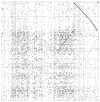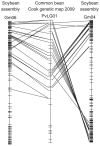Evolutionary and comparative analyses of the soybean genome
- PMID: 23136483
- PMCID: PMC3406793
- DOI: 10.1270/jsbbs.61.437
Evolutionary and comparative analyses of the soybean genome
Abstract
The soybean genome assembly has been available since the end of 2008. Significant features of the genome include large, gene-poor, repeat-dense pericentromeric regions, spanning roughly 57% of the genome sequence; a relatively large genome size of ~1.15 billion bases; remnants of a genome duplication that occurred ~13 million years ago (Mya); and fainter remnants of older polyploidies that occurred ~58 Mya and >130 Mya. The genome sequence has been used to identify the genetic basis for numerous traits, including disease resistance, nutritional characteristics, and developmental features. The genome sequence has provided a scaffold for placement of many genomic feature elements, both from within soybean and from related species. These may be accessed at several websites, including http://www.phytozome.net, http://soybase.org, http://comparative-legumes.org, and http://www.legumebase.brc.miyazaki-u.ac.jp. The taxonomic position of soybean in the Phaseoleae tribe of the legumes means that there are approximately two dozen other beans and relatives that have undergone independent domestication, and which may have traits that will be useful for transfer to soybean. Methods of translating information between species in the Phaseoleae range from design of markers for marker assisted selection, to transformation with Agrobacterium or with other experimental transformation methods.
Keywords: Glycine max; Legume Information System; Legumebase; Phytozome; SoyBase; legume evolution; polyploidy; soybean.
Figures





References
-
- Bennett M, Leitch I. Angiosperm DNA C-values database (release 5.0, December 2010) 2010.
-
- Campbell RJ, Hartman GR, Noel GR, Hymowitz T. Identification of resistance to soybean cyst nematode in Glycine tomentella. Phytopathology. 2000;91S:176.
LinkOut - more resources
Full Text Sources
Research Materials
